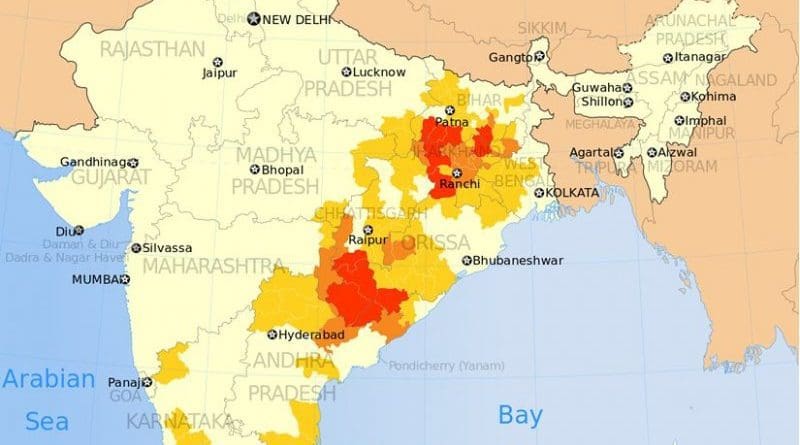Counter-LWE Security Operations: Season Of Success? – Analysis
On the surface, the months of April and May 2018 appear to have brought about a season of ‘success’ for Indian security forces. Pursuing a hardline approach, the security forces, across Maharashtra, Chhattisgarh, Odisha, and Jharkhand, have been able to kill a large number of left-wing extremists. The government has also truncated the list of the number of extremist-affected districts, bringing it down to just 30. It appears that the state’s objective of total decimation of left-wing extremism (LWE) is much closer than ever before. How real is that spectre?
Over 40 Maoists were killed in two back-to-back intelligence-led operations in Maharashtra’s Gadchiroli district by C-6 commandos of the state police on 22 and 23 April. Among the dead were three senior level commanders of the CPI-Maoist. While the outfit confirmed that only 22 of the killed were members, rights organisations have claimed that the entire operation was fake and among the dead were several villagers – men and women – from the area. The accusation has been refuted by the state authorities. Nevertheless, elimination of even 22 extremists does strike a serious blow to the operational ability of the CPI-Maoist, which is facing multiple challenges to its existence.
Successes, curiously, help to get over bad memories, even recent ones. Only a month before the Gadchiroli encounter, an explosion in Chhattisgarh’s Sukma district had killed nine Central Reserve Police Force (CRPF) personnel. The dead were among the personnel travelling in a Mine Proof Vehicle (MPV) that bore the maximum impact of the explosion. Post-Gadchiroli, the C-60 commandos were photographed posing with the dead bodies of the extremists and dancing in post-encounter celebrations. Hence, it is fair to conclude that the encounter, in which two of the extremists who had taken part in the Sukma attack were killed, merely fulfilled the urge to avenge loss, rather than advancing any strategic objective.
The investigation into the March 2018 Sukma attack had revealed a range of problems that continue to affect the counter-LWE security force operations, especially that of the central forces. Blame was heaped on the ill-suited MPV and a culture of indiscipline among the CRPF. Senior police officer and former director general of the Border Security Force (BSF), EN Rammohan, before his passing in April 2018, laid out why the CRPF personnel continue to err, even at the cost of their own lives. “Lack of leadership, failure in skill craft tactics, and lack of training” are the reasons he cited in a media interview. Company commanders and battalion commandants are not leading from the front. Officers of the level of sector inspector general do not even visit the battalions on a regular basis to spend time with the jawans and assess their level of discipline and training.
Rammohan incidentally had led a one-man commission to inquire into the 2010 encounter in which the CRPF had lost an entire company to an ambush by the Maoists. Even then, Rammohan found that the “CRPF had flouted each rule of the rule book” by “laundering around in the jungle without laying an ROP.” In eight years, even after the institution of commissions, successive chiefs infusing fresh expertise into the force, and exhaustion of significant resources, the capacities of forces have remained unchanged. This is the state-of-affairs among security forces of all hues, making them good enough for occasional successes such as the Gadchiroli encounter, but not on whose shoulders a decisive victory can be achieved.
This seemingly harsh assessment can be substantiated by a number of facts. Two are cited below. Firstly, between 1 January 2014 and 15 April 2018 (mostly pertaining to the tenure of the current government), extremists killed 314 and injured 708 security forces, a large number of them mostly in small and isolated encounters. Each of these attacks bore the same lacunae – capacity, training, and discipline deficiency – that Rammohan and others have underlined. Secondly, the government might choose to showcase the truncated list of 30 affected districts as an achievement. But the fact remains that Maoist domination over these 30 districts has remained undisturbed for past several years and eight of those 30 are in Chhattisgarh, a state where a mammoth 70 battalions of central forces are deployed in anti-LWE operations, besides a huge amassment of state police forces and vigilante groups.
On 11 May, Home Minister Rajnath Singh, while assessing the LWE situation in Chhattisgarh, admitted that his government was reluctantly pursuing a force-centric approach to the LWE problem and promised that Naxalism would be wiped out in the near future. All through his four-year tenure, Mr Singh has made similar predictions. While such promises excite laymen, for serious observers of LWE developments, these statements bear inherent signs of déjà vu. Under the UPA-I government, Home Minister Shivraj Patil gave the false hope that he could bring back ‘misguided’ extremists back to the mainstream. During UPA-II, P Chidambaram’s home ministry once promised that Operation Green Hunt could decimate the LWE in a few months. The current BJP government, in the fifth year of its tenure, is merely pursuing a ‘kill all extremists’ approach, without paying much attention to building capacity among the forces. While such an approach can produce occasional successes that thrill, whether an end to the LWE problem can be achieved is a genuine question begging for an answer.
This article was published at IPCS

